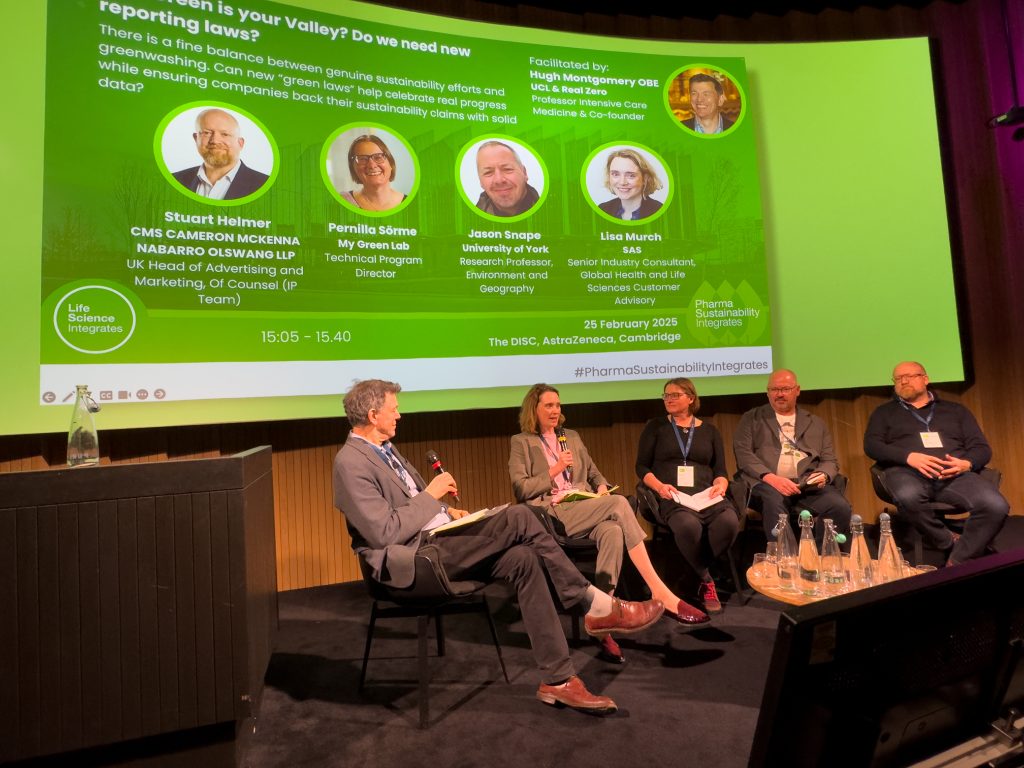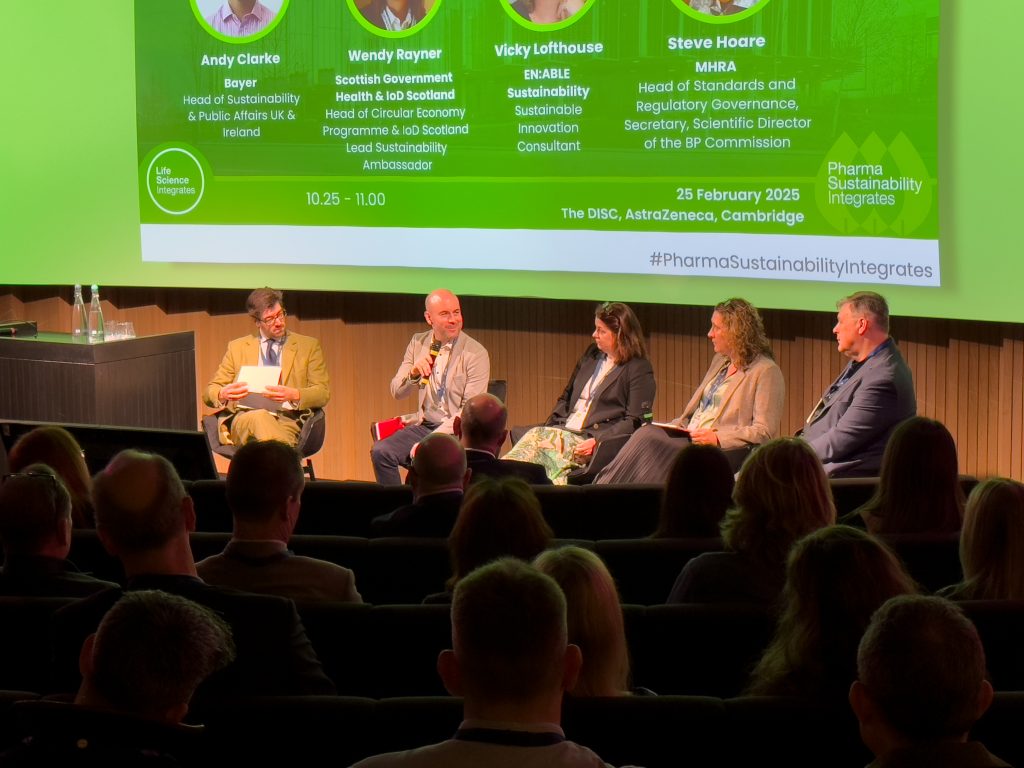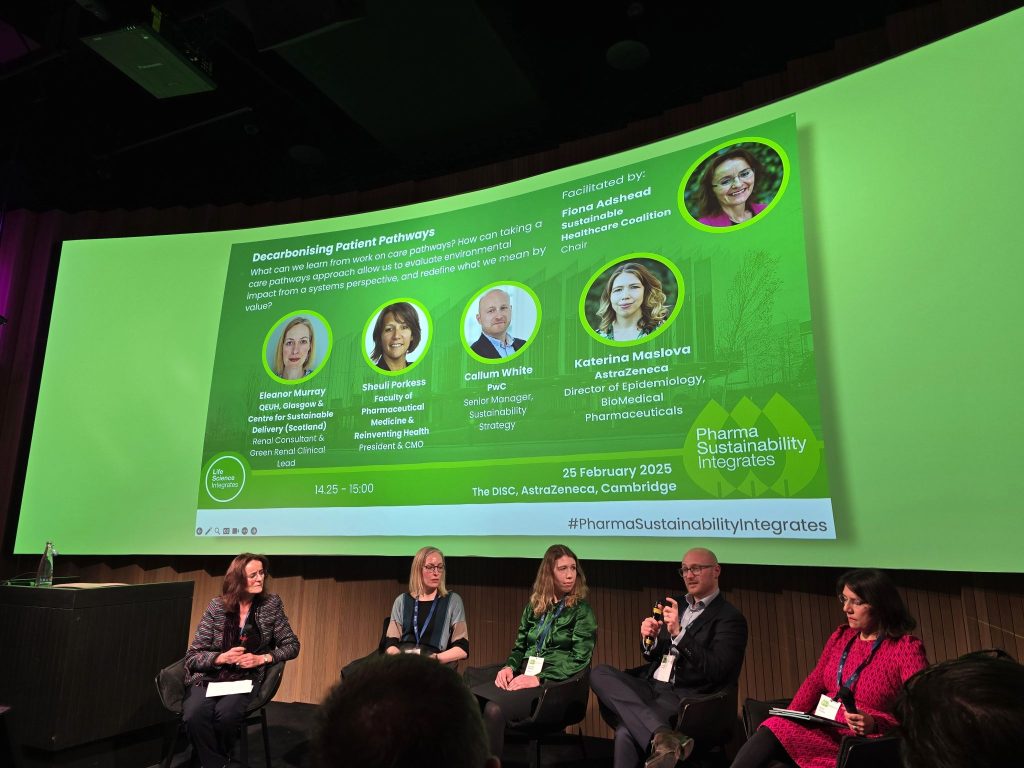
Set within the AstraZeneca Discovery Centre (DISC) in Cambridge, Pharma Sustainability Integrates 2025 brought together industry leaders, policymakers and sustainability experts to tackle one of the most pressing challenges in healthcare—building a truly sustainable pharmaceutical sector.
Hosted in partnership with AstraZeneca, this year’s event provided a dynamic platform for open dialogue, networking and cross-sector collaboration. The day was filled with insightful discussions, rousing calls to action and practical solutions for making sustainability a reality in pharma. The urgency of the sustainability challenge was made abundantly clear.

“We have to reduce emissions in absolutely everything we do by 15% every single year. And even that wouldn’t be enough to avoid catastrophe. We’re heading for a world with four times the radiative forcing we originally thought was dangerous. That means civilisation as we know it could collapse within 20 years, and a global mass extinction event within the lifetime of people in their 50s today.”
In this pharma sustainability industry insight report, we’ll explore the key takeaways and main themes to emerge – highlighting the biggest challenges, boldest ideas and most promising solutions driving sustainability in pharma and healthcare.
One of the strongest themes to emerge from Pharma Sustainability Integrates 2025 was the critical role of collaboration in achieving meaningful sustainability progress. Time and again, speakers emphasised that no single organisation, supplier or healthcare provider can tackle sustainability challenges alone; the scale of the task demands shared responsibility and joint action.
While most pharma companies have clear sustainability targets, the real challenge lies in execution—and that requires alignment across the entire value chain. The idea that sustainability efforts must be embedded into supplier relationships, cross-industry partnerships and healthcare systems was echoed in multiple discussions.
“The pharmaceutical industry is global, and so are its challenges. We are a product of our supply chains, and no single company can drive sustainability in isolation. True progress requires us to act collectively—aligning our goals, sharing ideas and working across the ecosystem to create lasting change.”
Panellists highlighted examples of successful partnerships already driving real impact. One standout case was AstraZeneca’s collaboration with Future Biogas, which has been instrumental in cutting Scope 1 and 2 emissions by providing renewable, UK-based biomethane energy to replace fossil fuels in manufacturing operations. This kind of strategic partnership showcases how cross-industry collaboration can accelerate decarbonisation efforts at scale.
With the healthcare sector responsible for approximately 5% of global carbon emissions, the pharma industry has both an opportunity and an obligation to lead. The consensus? True sustainability progress will not come from individual commitments alone, but from collective action and shared goals.
While many pharma companies have made significant strides in reducing their Scope 1 and 2 emissions—those generated directly by their operations and energy use—Scope 3 remains the industry’s biggest sustainability hurdle. Covering everything from raw material extraction to product transportation, packaging and end-of-life disposal, Scope 3 emissions typically account for 80-90% of a pharmaceutical company’s total carbon footprint. Throughout the day, speakers acknowledged that tackling Scope 3 is complex—but non-negotiable.

A key barrier identified was the lack of standardisation in emissions tracking and reporting. Without consistent data-sharing across suppliers, contract manufacturers and distribution networks, companies struggle to measure and verify progress.
“We’ve seen that that when companies align their data requests and sustainability targets, suppliers engage much more readily. If we want meaningful progress, we need to be working together in a pre-competitive environment, setting clear expectations and supporting suppliers on their sustainability journey.”
Multiple panellists underscored the urgent need for harmonised data reporting frameworks. For example in the clinical trials space, we learned of the urgent need for standardised sustainability metrics. Ongoing efforts to create low-carbon clinical trials models would help sponsors estimate and mitigate emissions from trial designs.
Another major focus for Pharma Sustainability Integrates was supplier engagement and incentives. Many pharmaceutical businesses have ambitious net-zero goals, but without structured support and incentives for suppliers, progress will inevitably be slow. Panellists highlighted the importance of long-term supplier partnerships, education initiatives and financial incentives to help suppliers decarbonise their operations.
Scope 3 is pharma’s most difficult challenge—but also its biggest opportunity. Companies that take proactive steps to collaborate, standardise and support supplier transitions will not only lead in sustainability, but future-proof their operations as regulatory and investor scrutiny intensifies.
Throughout the day, the conversation repeatedly turned to circularity—how the pharmaceutical industry can move away from the traditional “take, make, dispose” model and adopt smarter, more sustainable approaches to materials, waste and product design.
With strict regulatory requirements, sterility concerns and patient safety considerations, implementing circular economy principles in pharma is particularly challenging. However, speakers were clear—if other industries can make the shift, so can we.

“We have to stop seeing waste as inevitable. Circular solutions already exist, but adoption remains slow. If we integrate circularity into procurement policies, regulation and product design, we can create a system that is both more sustainable and more resilient.”
A key focus was designing sustainability into products from the start, rather than attempting to retrofit solutions later in the process. This means rethinking everything from packaging materials to drug delivery mechanisms. Companies leading in this space are already embedding end-of-life considerations into product development.
Waste reduction in pharma manufacturing is also key, particularly in solvent use and single-use plastics. While regulations often dictate the use of certain materials for sterility and safety, speakers explored where innovative alternatives—such as biobased plastics, green solvent alternatives and chemical building blocks—could help reduce the environmental impact of pharmaceutical production.
Collaboration and idea sharing was once again seen as critical, with panellists calling for greater transparency and regulatory alignment to accelerate circularity efforts. Some called for a rethink of policies that make material reuse difficult, suggesting that stronger incentives for sustainable product design and investment in circular infrastructure could drive real progress.
“Colgate openly shared the design of their recyclable toothpaste tube with competitors because they knew circularity would only work if everyone adopted it. That’s the mindset we need in healthcare.”
Circularity in pharma requires a shift in mindset. Moving beyond short-term fixes and towards systemic change in how materials are sourced, used and disposed of will be essential to making pharma a truly sustainable industry.
Another big topic of discussion at Pharma Sustainability Integrates was improving sustainability in patient care. We heard that treating critically ill patients is one of the most carbon-intensive aspects of healthcare, and to truly build a sustainable system, we need to shift our focus towards preventative medicine and early intervention. By embedding preventative care, digital health monitoring and home-based treatment models, healthcare systems can reduce both patient morbidity and their carbon footprint.

“We need to stop seeing sustainability as separate from patient care—it’s directly linked. A more efficient, preventative, and decentralised healthcare system isn’t just greener, it delivers better outcomes for patients too.”
Beyond prevention, AI, remote monitoring and decentralised care can further cut emissions by reducing unnecessary hospital visits and shifting care delivery closer to home. However, sustainability has rarely been factored into clinical decision-making—a patient needing treatment wouldn’t typically consider its environmental impact. While no universal framework exists yet, the discussions made it clear: integrating sustainability into prescribing and treatment guidelines is critical.
On the topic of sustainability in healthcare, one thing is abundantly clear: the time for action is now. While progress is being made, the challenges ahead— from decarbonising supply chains, to embedding circularity and transforming patient care—demand bold commitments, systemic change and a willingness to collaborate across sectors.
Our industry has the opportunity to lead the charge in building a more sustainable healthcare system. This should be one that doesn’t just reduce emissions, but creates better outcomes for patients, strengthens supply chain resilience and ensures long-term industry viability. The road ahead requires commitment, investment and a shift in mindset. But as the conversations at this year’s event proved, the appetite for meaningful change has never been stronger.
The challenge now? Turning that ambition into reality.
